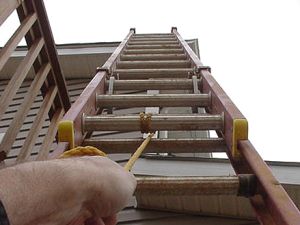Ladder Safety |
|
We commonly use ladders around the house for painting, gutter repair or clean
out and working on the roof. You should always use proper safety precautions.
Throughout the US there are an estimated 50,000 significant injuries and over
300 deaths each year as a result of working on ladders. |
 |
|
Items needed:
Step ladder
Extension ladder Scaffolding |
Safety Suggestions and Tips
READ THE INSTRUCTIONS on the ladder for weight limits.
If you are afraid of heights - DON'T CLIMB LADDERS! |
Level of difficulty
 Time Required: 1 hour
|
|
|
|
Steps |
|
|
|
|
Step 1: Ladder Selection The first step is pick the appropriate size ladder for the job. If you plan on working extensively in an area, you may want to use scaffolding, instead (Step 8). For example, a six-foot step ladder will only allow access about 10 feet above the ground. You should not use either the top platform of the ladder or the top-most step. |
|
Step 2: Check the Extension Ladder First examine the ladder while on the ground. Be sure that the rung locks are working. |
|
Step 3: Raising the Extension Ladder Assuming you need more to access more than 10 feet, raise the extension ladder, first placing the base of the ladder securely. It helps to have two persons for this job. |
|
Step 4: The ladder will be placed such there is one foot of distance for every four feet of height. This is the 4-to-1 rule. |
|
|
Step 5: On loose soil, the feet should firmly dig into the ground. On flat surfaces, the rubber feet should firmly grip. |
|
|
Step 6: Raise the extension ladder in the unextended position. Once upright, raise the ladder, pulling on the rope. Never climb past the third rung from the top of a ladder. If you plan to access the roof, the ladder should extend 3 feet past the edge of the roof. |
|
|
Step 7: Using a Step Ladder When using a step ladder, you should always open the ladder and place this about 2 feet from the wall or building. You should not lay the ladder against the building. |
|
|
Step 8: Using Scaffolding If you are using scaffolding, assemble the end units with cross ties where you plan to be working. The scaffolding is made of stackable units. |
|
|
Step 9: Start with assembling the feet, or at least protect the bottom-most stand by placing a block of wood to keep the base from sinking into the ground. |
|
|
Step 10: Be sure to keep the nuts and wing nuts lubricated. |
|
Step Ladders: Never climb past the second rung from the top. |
|
Extension Ladders:
Single section ladders should not exceed 30 feet |
|
All Ladders: Do not carry tools in hands. Use a tool pouch or belt. |
|
Ladders Inspection: GENERAL |
|
|